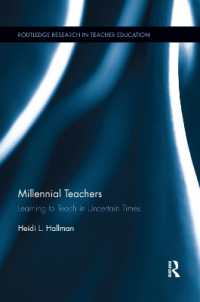- ホーム
- > 洋書
- > 英文書
- > Computer / General
Full Description
This two-volume set LNAI 16370-16371 constitutes the refereed proceedings of the 38th Australasian Joint Conference on Artificial Intelligence, AI 2025, held in Canberra, ACT, Australia, during December 1-5, 2025.
The 73 full papers presented together with 1 short papers were carefully reviewed and selected from 152 submissions. They were organized in following topical section:
Part I : Language and Foundation Models and Knowledge Representation and Data Mining,
Part II : Learning Algorithms, Computer Vision, AI for Healthcare and Reinforcement Learning and Robotics.
Contents
.- Learning Algorithms.
.- Price Equilibrium Routing: A Lightweight Framework for Expert Selection in Mixture-of-Experts.
.- Minimum Message Length t-test.
.- Towards Scalable Backpropagation-Free Gradient Estimation.
.- Coordinate-free k-means clustering.
.- The Ensemble Kalman Update is an Empirical Matheron Update.
.- Using Individual Problem Instances for Exploratory Black Box Optimisation Benchmarking: A Case Study Using XOR Neural Networks.
.- On Knowledge-Informed Deep Learning for Modelling Complex Spatiotemporal Systems.
.- Trajectory segmentation and self-supervised classification for subtask discovery.
.- Computer Vision.
.- NoPo3DFusion: Scaling Two Images to Long Videos via 3D-Aware Iterative Diffusion.
.- Gaussian Alignment for Relative Camera Pose Estimation via Single-View Reconstruction.
.- Street Depth-Aware Gaussian for Modeling Dynamic Urban Scenes.
.- Paired Hierarchical VAEs for Image-to-Image Translation and Cross Reconstruction.
.- When Language Model Guides Vision: Grounding DINO for Cattle Muzzle Detection.
.- AFFT: Adapter-based Few-shot Fine-Tuning Framework for Remote Sensing Object Detection.
.- Depth-aware Audio Visual Segmentation with Geometry-Heuristic Cross Attention.
.- EyeDentify: A Deep Learning Approach to Non-Invasive Biometric Identification from Eye Blink Patterns.
.- Augmentation and Transformation for Nighttime Cloud Segmentation in All-Sky Camera Images.
.- Room Envelopes: A Synthetic Dataset for Indoor Layout Reconstruction from Images.
.- PLNet-12: A Vision-Language Benchmark for Zero-Shot Physical Literacy Analysis Across 12 Fundamental Movements.
.- TrashTracer: Enabling efficient real-time detection of underwater marine debris.
.- AI for Healthcare.
.- A-PriDiff: Anatomical Prior-Guided Conditional Diffusion for Ultrasound Spine Image Synthesis.
.- MammoMix: Leveraging Mixture of Experts for Robust Mammogram Breast Detection.
.- TripletResNet: A Deep Metric Learning Approach for mTBI Diagnosis from 3D CT.
.- Efficient Craniofacial Microsomia Detection via Edge-focused 3D Point Cloud Network
.- Privacy-Centric Seizure Detection Using Surface Normals, Pose and Segmentation Masks.
.- An Explainable Graph Learning Framework for Severe Maternal Morbidity Prediction.
.- Personalized Federated Graph Learning for Heterogeneous Incomplete EHRs.
.- Structure Matters: Brain Graph Augmentation via Learnable Edge Masking for Data-efficient Psychiatric Diagnosis.
.- Reinforcement Learning and Robotics.
.- Evolving MCTS Macro-Actions in Real-Time Domains.
.- A Hybrid Multi-Agent Reinforcement Learning Framework for Decentralised Search-And-Interact Tasks Under Partial Observability.
.- Synergistic MARL: Unifying Physics-Informed, Meta Learning, and Hybrid Learning to Outperform Communication-Based Coordination.
.- Guardrail Guided Policy Optimisation: Learning Disentangled Safety Constraints.
.- The Consensus Paradox: When Low Disagreement Leads to Catastrophic Failure in Multi-Teacher Reinforcement Learning.
.- Towards Search Node-Specific HTN Heuristics.
.- Planner-Independent Extraction of Goals and Constraints from Natural Language for Open-World Mobile Robot Missions.
.- PERCY: Personal Emotional Robotic Conversational System.
.- Understanding Human Situation Awareness in One-to-Many Human-Robot Interaction Scenarios.
.- Learning Preferences in Additive Separable Hedonic Project Games.
.- Policy Gradient-Based Reinforcement Weighted Aggregation for Efficient Federated Learning on Heterogeneous Data.








